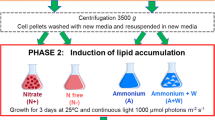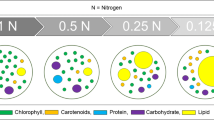Abstract
Oils, carbohydrates, and fats generated by microalgae are being refined in an effort to produce biofuels. The research presented here examines two marine microalgae, Nannochloropsis salina (green alga) and Phaeodactylum tricornutum (diatom), when grown with 0 (no addition), 0.5, 1.0, 2.0, and 5.0 g L−1 NaHCO3 added to an f/2 medium during the growth phase (GP) and a nutrient induced (nitrate limitation) lipid formation phase (LP). We hypothesize that the addition of NaHCO3 is a sustainable and practical strategy to increase cellular density and concentrations of lipids in microalgae as well as the rate of lipid accumulation. In N. salina, final cell densities were significantly (p < 0.05) higher in the NaHCO3-treated cells than the control while in P. tricornutum the cell densities were higher with >[NaHCO3] during the GP. During the LP, cell densities were generally higher in the NaHCO3-treated cells compared with controls. F V/F M (efficiency of photosystem II) patterns paralleled those for cell density with generally higher values with higher concentrations of NaHCO3 and significantly different values between controls and 5.0 g L−1 NaHCO3 at the end of the GP (p < 0.05). F V/F M was variable between treatments in P. tricornutum (0.3–0.65) but less so in N. salina for (0.5–0.7) regardless of [NaHCO3]. The lipid index (measured with Nile red), used as a proxy for triacylglycerides (TAGs), was 10.2 ± 6.5 and 4.4 ± 2.9 (fluorescence units/OD cells ×1000) for N. salina and P. tricornutum, respectively, at the end of the GP. At the end of the LP, the lipid index was eight and four times higher than during the GP in the corresponding 5.0 g L−1 NaHCO3 treatments, revealing that N. salina was accumulating more lipid than P. tricornutum. Dry weights essentially doubled during LP compared with GP for N. salina; this was not the case for P. tricornutum. In general, the percentage of ash in dry weights was significantly higher in the LP relative to the corresponding GP treatments for P. tricornutum; this was not the case for N. salina. During the LP, there was also less soluble protein in N. salina compared to GP; differences were not significant in cells growing with 2.0 or 5.0 g L−1 NaHCO3. In P. tricornutum, faster growing cells had more soluble protein during the GP and LP; differences between treatments were significant. P. tricornutum generally accumulated significantly more crude protein than N. salina at higher [NaHCO3]; there was three times more crude protein in the highest NaHCO3 (5.0 g L−1) treatment compared with the controls. C:N ratios (mol:mol) were similar across treatments during GP: 7.03 ± 0.12 and 10.16 ± 0.41 for N. salina and P. tricornutum, respectively. Further, C:N ratios increased with increasing [NaHCO3] during LP. Species-specific fatty acid methyl ester (FAMEs) profiles were observed. While C16:0 was lower in P. tricornutum compared to N. salina, the diatom produced more C16:1 and C14 but not C18:3. Monounsaturated fatty acids (MUFA) significantly increased in N. salina in the LP compared to GP and in response to increasing [NaHCO3] (t tests; p < 0.05). Saturated fatty acids (SFA) responded similarly but to a lesser degree. There were more polyunsaturated fatty acids (PUFA) in N. salina than MUFAs or SFAs. In P. tricornutum, there were generally more SFAs, MUFAs and PUFAs in P. tricornutum during LP than GP in the corresponding NaHCO3 treatments. These findings reveal the importance of considering NaHCO3 as a supplemental carbon source in the culturing marine phytoplankton in large-scale production for biofuels.





Similar content being viewed by others
References
Achara N (2012) Biofuel from algae. J Am Sci 8:240–244
Benemann JR, Weissman JC, Koopman BL, Oswald WJ (1977) Energy production by microbial photosynthesis. Nature 268:19–23
Berges JA, Falkowski PG (1998) Physiological stress and cell death in marine phytoplankton: induction of proteases in response to nitrogen or light limitation. Limnol Oceanogr 43:129–135
Brennan L, Owende P (2010) Biofuels from microalgae–a review of technologies for production, processing, and extractions of biofuels and co-products. Renew Sust Energ Rev 14:557–577
Chagoya J, Brown J, Gomez SM, Zhang J, Jiang Y, Laverty K, Brown L, Quigg A, Burow MD (2014) Media optimization and lipid formation of two native diatoms for cultivation in the southwest Texas desert. J Appl Phycol 26:2075–2085
Chen CY, Durbin EG (1994) Effects of pH on the growth and carbon uptake of marine phytoplankton. Mar Ecol Prog Ser 109:83–94
Chi ZY, O’Fallon JV, Chen SL (2011) Bicarbonate produced from carbon capture for algae culture. Trends Biotechnol 29:537–541
Chisti Y (2008) Biodiesel from microalgae beats bioethanol. Trends Biotechnol 26:126–131
Chisti Y (2007) Biodiesel from microalgae. Biotechol Adv 25:294–306
Conley DJ, Paerl HW, Howarth RW, Boesch DF, Seitzinger SP, Havens KE, Lancelot C, Likens GE (2009) Controlling eutrophication: nitrogen and phosphorus. Science 323:1014–1015
Cooksey KE, Guckert JB, Williams SA, Callis PR (1987) Fluorometric determination of the neutral lipid content of microalgal cells using Nile red. J Microbiol Methods 6:333–345
Dean AP, Sigee DC, Estrada B, Pittman JK (2010) Using FTIR spectroscopy for rapid determination of lipid accumulation in response to nitrogen limitation in freshwater microalgae. Bioresour Technol 101:4499–4507
Devgoswami CR, Kalita MC, Talukdar J, Bora R, Sharma P (2011) Studies on the growth behavior of Chlorella, Haematococcus and Scenedesmus sp. in culture media with different concentrations of sodium bicarbonate and carbon dioxide gas. Afr J Biotechnol 10:13128–13138
Elsey D, Jameson D, Raleigh B, Cooney MJ (2007) Fluorescent measurement of microalgal neutral lipids. J Microbiol Methods 68:639–642
Fon-Sing S, Borowitzka MA (2015) Isolation and screening of euryhaline Tetraselmis spp. suitable for large-scale outdoor culture in hypersaline media for biofuels. J Appl Phycol. doi:10.1007/s10811-015-0560-2
Gardner RD, Cooksey KE, Mus F, Macur R, Moll K, Eustance E, Carlson RP, Gerlach R, Fields MW, Peyton BM (2012) Use of sodium bicarbonate to stimulate triacylglycerol accumulation in the chlorophyte Scenedesmus sp. and the diatom Phaeodactylum tricornutum. J Appl Phycol 24:1311–1320
Gardner R, Peters P, Peyton B, Cooksey K (2011) Medium pH and nitrate concentration effects on accumulation of triacylglycerol in two members of the Chlorophyta. J Appl Phycol 26:1005–1016
Geider RJ, La Roche J, Greene RM, Olaizola M (1993) Response of the photosynthetic apparatus of Phaeodactylum tricornutum (Bacillariophyceae) to nitrate, phosphate, or iron starvation. J Phycol 29:755–766
Giordano M, Beardall J, Raven JA (2005) CO2 concentrating mechanisms in algae: mechanisms, environmental modulation, and evolution. Annu Rev Plant Biol 56:99–131
Giordano M, Kansiz M, Heraud P, Beardall J, Wood B, McNaughton D (2001) Fourier transform infrared spectroscopy as a novel tool to investigate changes in intracellular macromolecular pools in the marine microalga Chaetoceros muellerii (Bacillariophyceae). J Phycol 37:271–279
Gore M (2013) Growth rate of marine microalgal species using sodium bicarbonate for biofuels. Master’s thesis. Texas A&M University
Goswami RCD, Kalita N, Kalita MC (2012) A study on growth and carbon dioxide mitigation by microalgae Selenastrum sp.: its growth behavior under different nutrient environments and lipid production. Ann Biol Res 3:499–510
Griffiths MJ, Harrison STL (2009) Lipid productivity as a key characteristic for choosing algal species for biodiesel production. J Appl Phycol 21:493–507
Guillard RRL, Ryther JH (1962) Studies of marine planktonic diatoms. I. Cyclotella nana Hustedt and Detonula confervaceae (Cleve) Gran. Can J Microbiol 8:229–239
Gunawan S, Maulana S, Anwar K, Widjaja T (2011) Rice bran, a potential source of biodiesel production in Indonesia. Ind Crop Prod 33:624–626
Hannon M, Gimpel J, Tran M, Rasala B, Mayfield S (2010) Biofuels from algae: challenges and potential. Biofuels 1:763–784
Howarth RW, Marino R (2006) Nitrogen as the limiting nutrient for eutrophication in coastal marine ecosystems: evolving views over three decades. Limnol Oceanogr 51:364–376
Hu Q, Sommerfeld M, Jarvis E, Ghirardi M, Posewitz M, Seibert M, Darzins A (2008) Microalgal triacylglycerols as feedstocks for biofuel production: perspectives and advances. Plant J 54:621–639
Jayasankar R, Valsala KK (2008) Influence of different concentrations of sodium bicarbonate on growth rate and chlorophyll content of Chlorella salina. J Mar Biol Assoc India 50:74–78
Jiang Y, Yoshida T, Quigg A (2012) Photosynthetic performance, lipid production and biomass composition in response to nitrogen limitation in marine microalgae. Plant Physiol Biochem 54:70–77
Jiang Y, Laverty KS, Brown J, Nunez M, Brown L, Chagoya J, Burow M, Quigg A (2014) Effects of fluctuating temperature and silicate supply on the growth, biochemical composition and lipid accumulation of Nitzschia sp. Bioresour Technol 154:336–344
Kolber ZS, Prasil O, Falkowski PG (1998) Measurements of variable chlorophyll fluorescence using fast repetition rate techniques: defining methodology and experimental protocols. Biochim Biophys Acta 1367:88–106
Knothe G (2008) Designer biodiesel: optimizing fatty ester composition to improve fuel properties. Energy Fuel 22:1358–1364
Parkhill JP, Maillet G, Cullen JJ (2001) Fluorescence-based maximal quantum yield for PSII as a diagnostic of nutrient stress. J Phycol 37:517–529
Pimolrat P, Direkbusarakom S, Chinajariyawong C, Powtongsook S (2010) The effect of sodium bicarbonate concentrations on growth and biochemical composition of Chaetoceros gracilis Schutt. Kasetsart Univ Fish Res Bull 34:40–47
Quigg A, Al-Anasi M, Nour Al Din N, Wei C-L, Nunnally CC, Al-Ansari IS, Rowe G, Soliman Y, Al-Maslamani I, Mahmoud I, Youseff N, Abdel Moati MA (2013a) Phytoplankton along the coastal shelf of an oligotrophic hypersaline environment in a semi-enclosed marginal sea: Qatar (Arabian Gulf). Cont Shelf Res 60:1–16
Quigg A, Nunnally CC, McInnes AS, Gay S, Rowe G, Dellapenna TM, Davis R (2013b) Hydrographic and biological controls in two subarctic fjords: an environmental case study of how climate change could impact phytoplankton communities. Mar Ecol Prog Ser 480:21–37
Quigg A, Sylvan JB, Gustafson AB, Fisher TR, Tozzi S, Ammerman JW (2011) Going west: nutrient limitation of primary production in the northern Gulf of Mexico and the importance of the Atchafalaya River. Aquat Geochem 17:519–544
Quigg A, Beardall J (2003) Protein turnover in relation to maintenance metabolism at low photon flux in two marine microalgae. Plant Cell Environ 26:693–703
Raven JA, Beardall J, Giordano M (2014) Energy costs of carbon dioxide concentrating mechanisms in aquatic organisms. Photosynth Res 121:111–124
Revellame E, Hernandez R, French W, Holmes W, Alley E (2010) Biodiesel from activated sludge through in situ transesterification. J Chem Technol Biotechnol 85:614–620
Sawayama S, Inoue S, Dote Y, Yokoyama S-Y (1995) CO2 fixation and oil production through microalga. Energy Convers Manag 36:729–731
Singh J, Gu S (2010) Commercialization potential of microalgae for biofuels production. Renew Sust Energ Rev 14:2596–2610
Stansell GR, Gray VM, Sym SD (2012) Microalgal fatty acid composition: implications for biodiesel quality. J Appl Phycol 24:791–801
White DA, Pagarette A, Rooks P, Ali ST (2013) The effect of sodium bicarbonate supplementation on growth and biochemical composition of marine microalgae cultures. J Appl Phycol 25:153–165
Yeh KL, Chang JS, Chen WM (2010) Effect of light supply and carbon source on cell growth and cellular composition of a newly isolated microalga Chlorella vulgaris ESP-31. Eng Life Sci 10:201–208
Zhu CJ, Lee YK (1997) Determination of biomass dry weight of marine microalgae. J Appl Phycol 9:189–194
Acknowledgments
This work is the result of research funded by Undergraduate Research Scholars Program at Texas A&M University, Galveston campus and a Welch Foundation (BD 0046) grant scholarship to MN. We thank Yuelu Jiang, Matthew Gore, and Salem Harry for assistance in the laboratory activities and helpful discussions. We also thank the two anonymous reviewers for their comments on this manuscript.
Author information
Authors and Affiliations
Corresponding author
Rights and permissions
About this article
Cite this article
Nunez, M., Quigg, A. Changes in growth and composition of the marine microalgae Phaeodactylum tricornutum and Nannochloropsis salina in response to changing sodium bicarbonate concentrations. J Appl Phycol 28, 2123–2138 (2016). https://doi.org/10.1007/s10811-015-0746-7
Received:
Revised:
Accepted:
Published:
Issue Date:
DOI: https://doi.org/10.1007/s10811-015-0746-7




